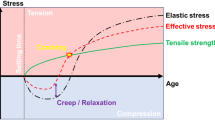Abstract
It is well known that the application of the principle of superposition in the service stress range yields an inaccurate prediction of concrete creep when unloading takes place. It appear that after a period of compression creep, the experimental creep recovery is significantly less than predicted by the principle of superposition. In the present study, this non-linear behaviour, attributed to the sustained compressive preload, is modelled by a two-function method. In this approach, a creep function is used for modelling the time-dependent deformations due to increasing stress and a separate creep recovery function represents the behaviour under decreasing stress. Good agreement with test data is achieved.
Resume
L’application du principe de superposition pour calculer les déformations de fluage du béton peut souvent donner des déviations considérables par rapport aux résultats expérimentaux. Plus particulièrement on constate, après une période sous compression constante, que la recouvrance réelle est nettement plus petite que la valeur calculée. Dans le présent article, le problème est résolu en introduisant une méthode qui utilise deux fonctions différentes à savoir une fonction modélisant le fluage propre et une deuxième fonction représentant la recouvrance due à une diminution de contrainte. Cette deuxième fonction a été établie récement sur la base de résultats d’essais obtenus dans le Laboratoire Magnel.
Similar content being viewed by others
References
Bažant Z. P. and Kim, S. S., ‘Nonlinear creep of concrete— adaptation and flow’,J. Eng. Mech. Div., Proc. ASCE 105, (EM3) (1979) 429–446.
CEB, ‘Evaluation of the time dependent behaviour of concrete’,Bulletin d’Information No. 199 (1990).
Bažant, Z. P., Tsubaki, T. and Celep, Z. ‘Singular history integral for creep rate of concrete,’J. Eng. Mech. 109, (3) (1983), 866–884.
Bažant, Z. P. and Asghari, A. A. ‘Constitutive law for nonlinear creep of concrete’,J. Eng. Mech. Div., Proc. ASCE 103 (EM1) (1977) 113–124.
Yue, L. L., ‘Creep recovery of plain concrete under uniaxial compression’, PhD thesis, University of Ghent (1992).
Press, W. H., Flannery, B. P., Teukolsky, S. A. and Vetterling, W. T., ‘Numerical Recipes in Pascal—The Art of Scientific Computing’ (Cambridge University Press, 1989).
Illston, J. M., ‘The components of strain in concrete under sustained compressive stress’,Mag. Concr. Res. 17 (50) (1965) 21–28.
Brooks, J. J. and Neville, A. M., ‘A comparison of creep, elasticity and strength in tension and compression,’-ibid. 29 (100) (1977) 131–141.
Müller, H. S., ‘Zur Vorhersage des Kriechens von Konstruktionsbeton’, Doctoral thesis, University of Karlsruhe (1986).
CEB, ‘Structural effect of time-dependent behaviour of concrete’,Bulletin d’Information No. 142/142Bis (1984).
Yue L. L. and Taerwe L. ‘Creep recovery of plain concrete and its mathematical modelling,’Mag. Concr. Res. 44(161) (1992) 281–290.
Author information
Authors and Affiliations
Rights and permissions
About this article
Cite this article
Yue, L.L., Taerwe, L. Two-function method for the prediction of concrete creep under decreasing stress. Materials and Structures 26, 268–273 (1993). https://doi.org/10.1007/BF02472948
Issue Date:
DOI: https://doi.org/10.1007/BF02472948




